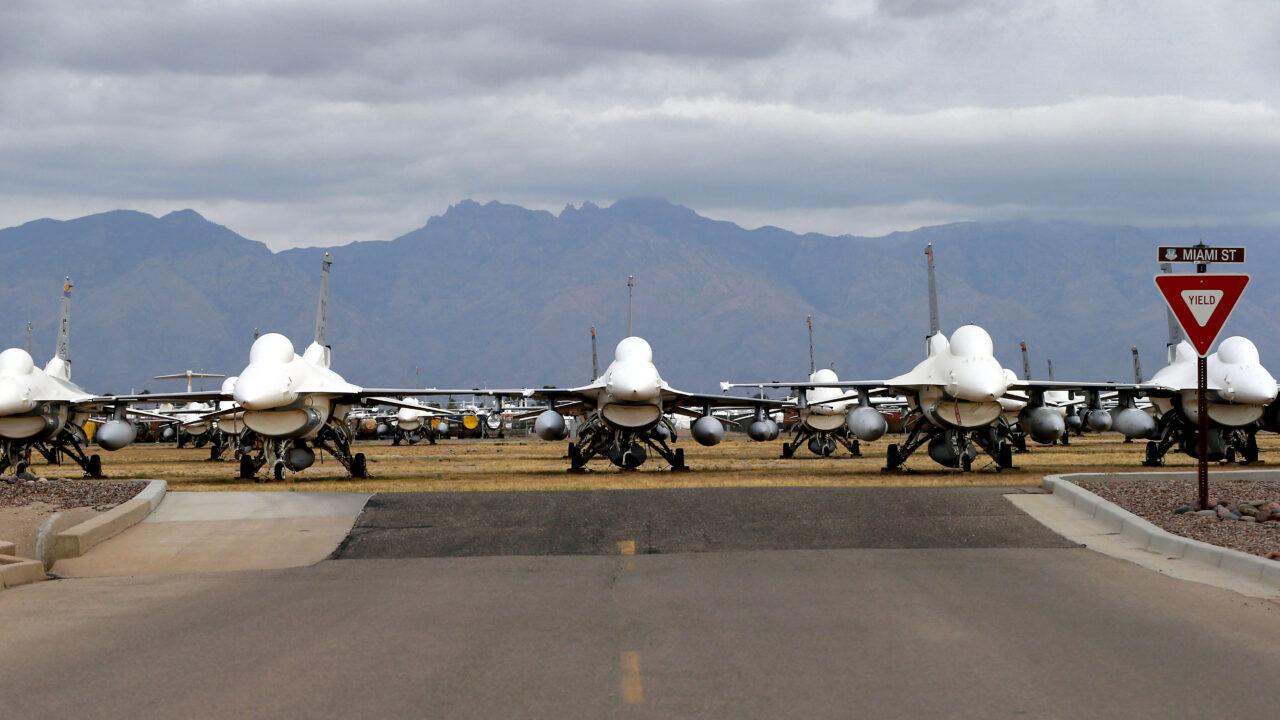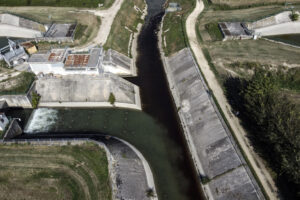Defense Department Defies EPA Order on ‘Forever Chemicals’
The U.S. Air Force cites the Supreme Court’s overturning of the Chevron Doctrine in evading the directive. F-16 Fighting Falcons sit in a field at the 309th Aerospace Maintenance and Regeneration Group boneyard at Davis-Monthan Air Force Base in Tucson, Ariz., in 2015. (AP Photo/Matt York)
F-16 Fighting Falcons sit in a field at the 309th Aerospace Maintenance and Regeneration Group boneyard at Davis-Monthan Air Force Base in Tucson, Ariz., in 2015. (AP Photo/Matt York)
In “Dr. Strangelove,” the fictitious base commander Jack D. Ripper orders a first-strike nuclear attack on the Soviet Union to enact revenge for contaminating American water to “impurify all of our precious bodily fluids.” The satirical film poked fun at rampant Cold War conspiracy theories about fluoridating our water supply. But as it turns out, America’s water was being contaminated — not by the Russians, but by the Pentagon.
Not long after American audiences packed into theaters to watch the bleak Cold War comedy, the Department of Defense ramped up its use of a fire suppressant called AFFF, knowingly contaminating the drinking water of millions of Americans.
Now, the Department of Defense is refusing to take accountability.
This week, the Air Force claimed it has no legal obligation to comply with an order from the Environmental Protection Agency in May to abate the threat of “forever chemicals” to the drinking water of Tucson, Arizona. The EPA order required the Air Force to create a system designed to treat high levels of per- and polyfluoroalkyl substances — synthetic chemicals known as PFAS that are linked to weakened immunity and other health risks — in drinking water, estimated to cost $25 million.
The Air Force is hoping to evade the EPA’s directive by citing the Supreme Court’s overturning in June of the Chevron Doctrine.
Testing at the Tucson International Airport Area Superfund Site has revealed PFAS levels of up to 5,300 times beyond the drinkable limit, which is “likely to enter into the Tucson public water system,” according to the EPA. These chemicals probably originated from the use of AFFF at airports and military sites, such as nearby Davis-Monthan Air Force Base and Morris Air National Guard Base.
The EPA also identified other chemicals that migrated into the groundwater from a weapons manufacturing facility just south of Tucson operated by RTX (formerly known as Raytheon).
The Air Force is hoping to evade the EPA’s directive by citing the Supreme Court’s overturning in June of the Chevron Doctrine, a longstanding legal doctrine that gave deference to regulatory agencies in interpreting gray areas in the law. But, according to critics of the Air Force’s maneuver, the enforcement of rules adopted by these agencies, as opposed to the interpretation of the rules themselves, was not covered by the Court’s decision.
Deborah Ann Sivas, director of the Stanford University Environmental Law Clinic, told the Guardian that “the Air Force is essentially attempting to expand the scope of the court’s ruling to thwart regulatory orders not covered by the decision.” The EPA noted in its May order that non-compliance could incur a civil penalty of nearly $30,000 a day, as well as civil lawsuits by private citizens.
In April, after the EPA released long-awaited, legally enforceable standards for PFAS levels in drinking water, a Pentagon spokesperson explained to Responsible Statecraft via email that “DoD remains committed to fulfilling our PFAS-related cleanup responsibilities and will take necessary actions to implement the rule.” Has that now changed?
The latest chain of events appears consistent with a pattern of the Pentagon’s shirking of taking responsibility for its contamination of PFAS. Despite knowing about the health effects of PFAS as early as the 1970s, the Pentagon probably serves PFAS-contaminated drinking water to some 600,000 service members every year, according to a 2022 analysis by the Environmental Working Group.
“The Department of Defense has known about the contamination of PFAS for decades,” Melanie Benesh, vice president for Government Affairs at the Environmental Working Group, said. “It took them a long time to start testing, and they have been trying to slow-roll their cleanup.”
Treating PFAS is all the more difficult when the Pentagon continues to risk contaminating groundwater with AFFF. According to a July Government Accountability Office report, the Pentagon uses AFFF in about 1,500 facilities and over 6,800 mobile assets around the world.
“The Air Force is essentially attempting to expand the scope of the court’s ruling to thwart regulatory orders not covered by the decision.”
The Pentagon has made some progress in transitioning away from AFFF use — because it is legally obligated to do so. In 2020, Congress ordered the Pentagon to phase out the use of AFFF by October of this year and transition to a PFAS-free alternative, with the possibility of two one-year extensions. The Pentagon already appears keen to invoke the extensions, telling Congress in February that “completing the transition of these systems within the required timeframe will be a challenge.”
The Pentagon is dragging its feet due to the transition’s costs, as well as the cleanup costs incurred by the chemical’s continued use. But you can’t have it both ways. The Pentagon’s calculated cost of a transition to PFAS-free fire suppressant amounts to $2.1 billion across all service branches, a paltry sum compared to the $38 billion estimate of cleaning up PFAS-contaminated sites. Continued use of AFFF increases the cleanup costs.
If the Air Force’s defiance of the EPA’s order is any indication, not everyone is on the same page about the importance of reducing PFAS contamination. While some in the Pentagon are taking their legal obligations seriously, others are looking for a loophole to continue the same pattern of punting responsibility to the next year — or perhaps another administration.
Your support is crucial...As we navigate an uncertain 2025, with a new administration questioning press freedoms, the risks are clear: our ability to report freely is under threat.
Your tax-deductible donation enables us to dig deeper, delivering fearless investigative reporting and analysis that exposes the reality beneath the headlines — without compromise.
Now is the time to take action. Stand with our courageous journalists. Donate today to protect a free press, uphold democracy and uncover the stories that need to be told.





You need to be a supporter to comment.
There are currently no responses to this article.
Be the first to respond.